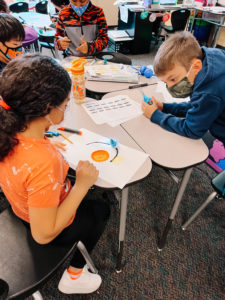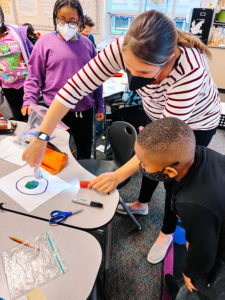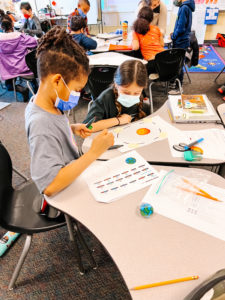March is Women’s History Month. At Ozobot, we like to commemorate the occasion by honoring extraordinary women who champion CS education both in and out of the classroom.
So, it should come as no surprise that this month’s Outstanding Educator Spotlight is an inspiring female teacher, coach and Ozobot Certified Educator whose continued advocacy and contributions to furthering STEAM education at Chris Yung Elementary are valued by students, parents and teachers alike. We’re thrilled to announce Kaitlin Chidester as our featured March educator!
As a STEAM educator at Chris Yung, Kaitlin uses the engineering design process to expose students in grades K-5 to problem-based learning. In her coaching role, she provides professional development opportunities for teachers and assists them with the integrated implementation of STEAM in the classroom.
Read on to learn about Kaitlin’s teaching strategies during the pandemic, how she uses Ozobot to engage her students, and why she loves being a STEAM educator and coach.
What are some of your key learnings from the last two years that you’ll continue to use in 2022 and beyond?
Navigating the difficult period of virtual and hybrid learning fundamentally changed the way teachers in our building taught daily lessons; it also changed the way we as a school collaborated with each other. Even though we were separated physically, we created ways to come together across grade levels to communicate and share ideas.
By layering in a variety of digital tools, we had a unique opportunity to present our entire building with engaging lessons to help them grow as 21st-century learners, even during a pandemic. One of those digital tools that we relied on heavily, and will continue to use into 2022 and beyond, is Flipgrid. This platform allows teachers and students to spark meaningful discussions and inspires our students to share their voices and creativity. Flipgrid allowed us to bring together our community of 700+ students at a time when we were all so isolated.
In collaboration with the school technology coach, we created a weekly creativity challenge that involved the entire building, from our littlest learners in kindergarten all the way up to our fifth graders. The challenges are simple and involve a wide variety of topics. Some are art-based, others are linked to music, while others are more number and word-based. The goal, refocus on creative and critical thinking as a vital skill for our learners as they prepare for the future ahead of them.
As a result, the walls of their individual classroom came down as their videos started popping up. The social aspect of the platform allowed for a fourth grader to respond to the video of a first-grader they had never met, and that inspires more creativity. While the pandemic has been unequivocally challenging, it has also inspired creativity and built relationships across our entire building that might not have otherwise happened.

What have been your favorite Ozobot projects recently? What impact did they have on your students?
Easily my favorite Ozobot project from this year involved our fourth graders and their unit on the earth-moon-sun system. Students were tasked with completing three increasingly complex challenges that used an Ozobot Evo robot to represent the various concepts related to the earth-moon-sun system.

The first challenge was a simple one; it had students use the Ozobot as the moon revolving around the earth. This concept can be a difficult one to visualize. Using the Ozobot changed everything. Students could see how the same side of their moon Ozobot always faced earth. We even pulled out flashlights to show changing phases of the moon as the light hit the Ozobot.
The second part of the challenge involved demonstrating the relationship between the earth and the sun with the Ozobot being used to represent the earth. Students needed to draw an orbit for their earth Ozobot that included codes for both the rotation of the and the changing of the seasons as the earth progresses along its path.
For their final challenge, student groups were paired together to use two Ozobots to represent both the earth and moon as they relate to the sun. The focus was using code to model what happens during a solar and lunar eclipse. This one required a more detailed understanding of Ozobot Color Codes.
The Ozobots allowed students to take their understanding of the earth-moon-sun relationship and apply it in a hands-on way with some creative and critical thinking added in. We did not give them all the answers and the codes to use, instead, we wanted them to select and apply their understanding in a way that made their learning their own.

How would you “grade” the current state of CS education in Virginia? What do you see changing or hope to see change in the coming years?
As a professional engineer that moved into education, I have had a passion for sharing the importance of CS for many years. We live in a digital world and the future involves understanding how computers think and interact. It’s not just about teaching kids to code because they may be a programmer one day; it’s about teaching them the skills related to computer science so they can be successful in any job.
When the State of Virginia released CS standards, I had high hopes that there would be a large-scale rollout and CS would be embraced at all levels. The reality, though, is that evolution has been a little slower than I would have liked to have seen. There are small pockets of educators who are advocating for computer science education but it hasn’t seemed to have caught a widespread wind yet. For many, computer science is this big scary concept that is not very well understood. There’s a fear associated with it, a fear as to where to start and a fear of not knowing enough to have an impact on our learners. That fear makes it even more difficult for educators to find ways to effectively integrate.
I hope that in the coming years those small pockets of educators are supported by a force at a higher level to help bring CS to all students. We have to continue to see teacher education around computer science to help ease some of the nervousness. We need to support educators in seeing the full picture of why computer science matters.
The kids need exposure to computer science as a foundation for their future careers; we must be brave enough to start out on the path of including CS in our daily learning even if we don’t have all the answers.
Why do you love being a STEAM educator?
The real-world connection to learning is what gets me excited about being a STEAM educator. Through STEAM, students get an opportunity to put their learning into action. They can see the why behind their learning and that it is more than the test at the end.
The topics and ideas that students are learning through STEAM-based projects are jobs, real-life jobs, that they can reach for. Jobs that could change the world. If students are learning about watersheds we can give them worksheets and packets of information or we can challenge them to build a device to help view a watershed’s health in areas of need. The learning of content still happens along the way but with a purpose. If students are learning about the salinity of the ocean we can show them videos explaining the concepts and move on to a new topic or we can challenge them to be educational software designers and have them program a game to teach others about the ocean. We can still assess their understanding of the concepts at the end of the unit but through a real-life scenario and not a scripted set of questions. It is not just learning to learn. STEAM gives them a reason to want to continue learning. STEAM puts the learning in the real world and shows them the why. The best part is when you see it all come together. That ‘ah ha’ moment when connections are made. That’s my reason. That’s what gets me excited about my job as a STEAM educator!
Connect with Kaitlin on Twitter to chat, share ideas, and stay up to date on her latest projects. For more free STEAM lessons and activities to bring into your classroom or at home, check out Ozobot Classroom.









